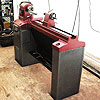I've resawn a 2"x6"x8ft plank of shedua (or ovangkol) into two planks.
Now I have two planks which are cupped along their length.
I.e. if I place a 6ft straightedge along one of the resawn planks, I can measure almost ½" cup.
Since the resawn thickness is approx 1" and I need the full length of the plank (8ft), nothing will probably be left after jointing and planing the plank.
Is there a way I can straighten the cupped plank? - e.g. making the cupped side wet or similar?
I know it's probably not doable, but I'm desperate after I just (most likely) ruined an entire plank of shedua (since I need the entire length in one piece).




 Reply With Quote
Reply With Quote









